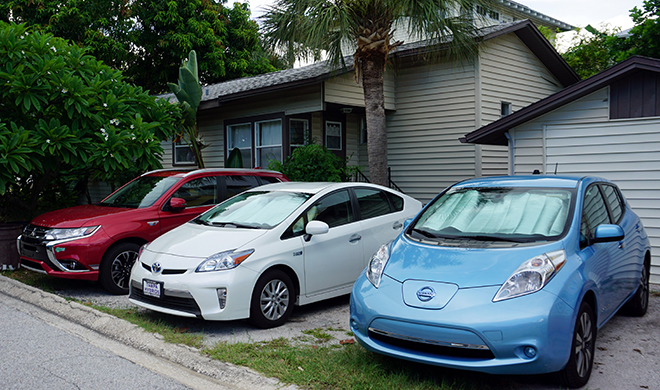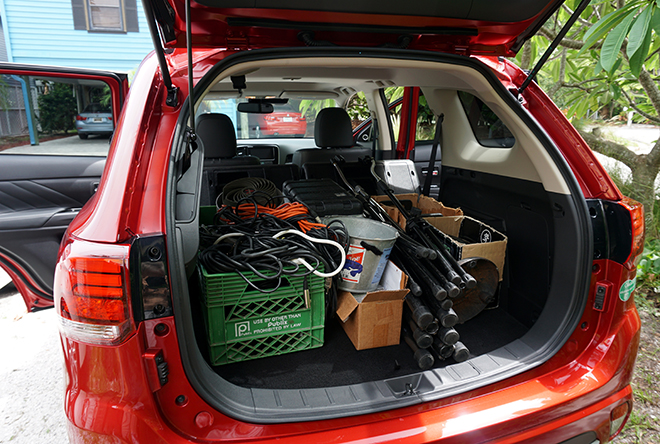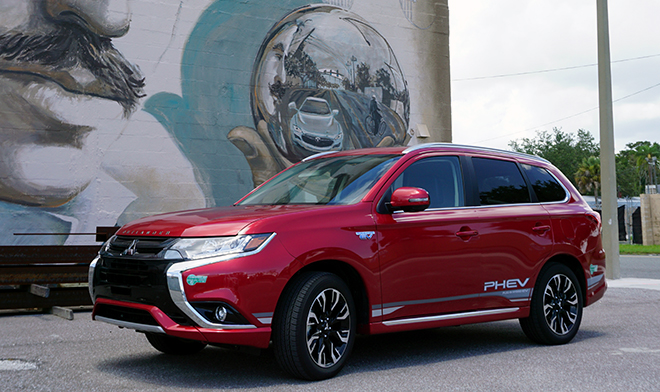As a tree-hugging greenie, I tend to be prejudiced against SUVs, but after a week with the Mitsubishi Outlander PHEV, I couldn’t really find anything not to like. This medium-size crossover drives great, it’s comfortable, and it has all the high-tech goodies we’ve come to expect. The electric range of 22 miles is enough to take trips around town without using any gas.
An SUV should excel at cargo carrying, and the Outlander delivers the goods. The cargo floor is low, there’s no liftover to speak of, and the rear seats fold perfectly flat, thanks to a clever spring-loaded device: pulling on a strap sproings the seat bottoms out of the way and allows the seat backs to fold down flat.
That said, on a square footage basis this SUV has less space than my Prius (I know, you’re all tired of hearing about Saint Prius). The two vehicles’ cargo decks are the same width, but that of the Prius is actually about four inches longer (because of the way the seats fold down). In terms of height, the Outlander beats the Prius by about five inches, and its rear compartment is more box-like (that is, the rear wall is close to vertical, whereas that of the Prius slopes down towards the back). So you could certainly fit more cargo in the Outlander, but it might require stacking objects on top of one another or standing them on end. Of course, the SUV does have slightly larger seats and more passenger headroom.

Every plug-in hybrid is slightly different in terms of how you can control the interaction between the gas engine and the electric motor. The Outlander seems a little shy about its electric capabilities. Unlike most other PHEVs, the gas engine often kicks in when in so-called EV Mode, and the electric range gets drawn down even when in Normal (hybrid) mode. According to the manual, in EV Mode, the electric motor is used “whenever possible” (we thought that was how an ordinary hybrid worked). There’s also a Charge Mode, in which the engine will charge the battery and increase the electric range, and a Hold Mode, in which the electric range will not be drawn down. One bizarre and annoying feature: cruise control can’t be used in EV Mode. As soon as you set a cruise speed, EV Mode is cancelled and the gas engine fires up.
The Outlander is the only PHEV we’re aware of that features DC fast charging – there’s a CHAdeMO port next to the standard Level 2 port. It’s hard to see the point of this – the main purpose of DC fast charging is to enable a pure EV to make long road trips, and that isn’t an issue with a PHEV. This feature, which surely adds a grand or so to the price of the vehicle, may be desirable for some buyers, but it would have been wiser to make it an option. Ditto the AWD, which is standard on both trim levels.
The base SEL model is quite well-equipped, with 1,500 pounds of towing capacity, digital HD radio, USB and power outlets, loads of handy hooks and compartments and a whizzy power liftgate. The GT model adds safety features such as Forward Collision Mitigation, Lane Departure Warning, and the Multi-View Camera System, as well as two standard AC outlets with a combined 1,500-watt power supply (handy for outdoor adventures).

If you want a plug-in SUV, I think you’ll be delighted with the Outlander, apart from the quibbles noted above. In the US, your only other options at the moment are compliance cars of dubious permanence from Volvo, BMW and Porsche, all of which have shorter electric ranges and higher price tags (of course, there’s also the category-killing Tesla Model X, which starts at around double the price of the Outlander).
In fact, given our nation’s adoration of SUVs, my question is, why isn’t this vehicle more popular than it is? It went on sale in the US last December, and so far sales have been modest – around 2,300 units through July. In the UK, the Outlander PHEV is the second-most popular plug-in vehicle – it sold 1,800 units there in the first quarter alone (it’s also #3 in Japan).
One reason for the middling sales figures could be the (apparent) price tag. The plug-in Mitsu will cost you $34,595 for the SEL trim, or $40,295 for the GT. A boring old gas-powered Outlander starts at $23,945 (or $25,445 with AWD). However, the Outlander PHEV is eligible for a $5,836 federal tax credit, and California residents can claim an additional $1,500 rebate (some other states also have deals available). That brings the SEL plug-in within two grand of the AWD gas model, and even a medium-mileage driver will recoup that in fuel savings within a couple of years. Plus, you’ll enjoy the superior electric driving experience, HOV lane access, and the ability to power AC accessories without running the engine.

Memo to Mitsubishi: Want to see these vehicles start flying off the lots? Make DC fast charging and AWD optional, and for Pete’s sake, mention the federal and state purchase incentives on your web site!
- Battery: 12 kWh
- Engine: 2.0 liters, 117 hp
- Motors: Twin 60 kW AC synchronous
- Fuel economy: 74 MPGe; 25 MPG combined
- Electric range: 22 miles
- MSRP: SEL trim: $34,595; GT trim: $40,295 (plus $995 “destination and handling fee”). Eligible for $5,836 federal tax credit.



















































































